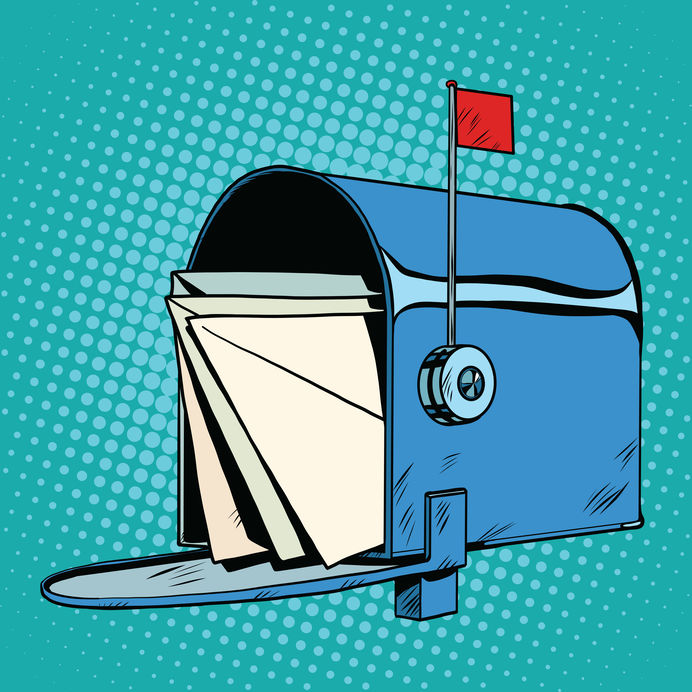I’ve spent a good decade and a half defending direct mail. Mostly in response to anxious nonprofit insiders saying things like “I’d hate to get all the mail we send.”
I won’t pretend everyone you mail wants it. And I won’t pretend everyone who gets your mail even reads it.
But many of them want your mail.
And many of them love your mail.
I’d like to take you on a walk-through of the ways real people consume direct mail.
What follows I believe to be true, or as close to true as 15 years in the trenches gets me. My hope is you find some tips and tactics you may not have considered or maybe just a good check-list for you to use.
First of all, let’s admit it: No matter what you send, no matter how you present it, some people will simply not give your (or any) mail pack any attention at all. My reading of the scant research on this suggests as many as eight, and as low as four, out of 10 people you mail simply dump your mail into the bin with barely a glance.
Those who remain are willing to grant you around 15 or 20 seconds of their attention. First the envelope and then whatever comes out first — if they open it.
They scan at headlines, pictures, captions, and the elements you’ve highlighted in some way. But they’re not reading. They’re just scanning to see if your mail is interesting or relevant or valuable. And about half quickly conclude that it’s not.
Into the bin.
So how can you make it through the first cut — the throw it out without even looking cut? And then the second cut — the throw it out unless something grabs their attention?
- Accept you aren’t the audience and put your personal opinions aside.
- Respond to the way people who do consume direct mail do it.
Let’s focus on the group that gives their mail some attention. What do they look for?
Their name. Spelt correctly. This is the first reason to not thrown it in the bin.
Maybe your logo. I’ve tested outer envelopes a lot. Of the tests that did deliver statistically significant results the outcomes varied by charity. For some a plain, unbranded, no message outer works best. For me this is the element of surprise – What is inside? Who is it from? For others the logo being present works better. Very rarely did a teaser message win. The main time a designed outer envelope has won was with animal welfare and children’s charities where compelling, emotive images of puppies, kittens or children beat the no design versions.
So you got them to open the pack. What do they do then? Consider you need to cater to three types of readers.
1. Sally Scanner. She starts skimming to get some details. My hope is your pack insertion order means the first thing Sally sees is the letter (and if you’ve never considered your pack insertion order please do, it’s your first moment of truth). So, assuming Sally comes across the letter first this is what she does.
- Is it addressed to me?
- What does the Johnson Box say?
- Who is it from?
- What does the PS say?
- What jumps out at me?
- Is it easy to read?
- Is it about me?
- Is it easy to respond / do what I’m being asked to do?
2. Dutiful Deb. Deb dives in a bit more than Sally. She’s probably a seasoned charity giver. She probably got several appeals at the same time as yours. She’s scanning a bit more deeply because it’s the right thing to. And Deb is looking for something to trigger her interest, something to entertain her, to engage her, to respond to values she shares with your cause.
3. Excited Elaine. Elaine expects your mail. She likes it. She sits down and reads the letter, the response form and the other pieces you’ve included. She is going beginning to end.
Your direct mail letter is a one-to-one conversation between the letter’s signer and Sally, Deb or Elaine, and nothing assures them that your message is intended for them better than seeing their name at the beginning of the letter. People love to see their name, and today’s technology makes it cost-effective to personalise your mailing. The marginal cost saving of not personalising is not worth the drop in response.
Before moving from the salutation to the signature, most readers will take a fraction of a second to scan whatever is visually obvious at the top of the letter … the material often called the Johnson Box.
Knowing this, you can use a Johnson Box, along with underlining, highlighting, bolding, and notes written in the margin to call attention to your call to action, and to pull the reader’s eyes across and down the page.
When we work with direct mail, we can get bored of a standard letter format. But a standard letter format is what works. If it didn’t, the format would have changed. We would have stopped writing letters home to mum this way and done something different.
After scanning the letter and perhaps reading the Johnson Box and/or opening paragraph, the reader will typically look to see who signed the letter.
It helps to print the signatory’s name and title under the signature and avoid “creative” signatures. Scribbled signatures don’t build trust, and eye-flow studies show that readers respond negatively to a signature they can’t read.
Once readers see who signed the letter, many will read the P.S. before moving back to the top of the letter. Not using a P.S. is simply a missed opportunity.
Keep the P.S. to three to four lines and use it to restate your call to action and tell the donor exactly how they can respond.
If you can personalise the P.S., do it. Inclusion of the recipient’s name at the beginning of the postscript draws even more attention to this recap of your call to action — and this call to action should include your ask, using a personalised ask amount derived from each donors previous giving level.
How you choose to format your letter (and any other elements of your pack) will impact its readability. FACT: Pretty does not necessarily equal readable.
To make your letter visually inviting, keep your paragraphs short, left justify your lines and provide plenty of space for your left and right margins.
Indent your paragraphs—they “catch” the reader’s eyes and help lead them down the page—double space between paragraphs. 12 point font is the absolute minimum, but I’d rather you use 14 point. I know you want to save costs and keep letter length to two pages … well all you are doing by sending out a 10 point font letter is turning away your audience. Too small = too hard.
For enhanced readability, use a serif font—Courier, Times New Roman and Georgia are examples—for the letter. Practically every book, newspaper or magazine printed in the Western world uses serif type because it enhances reading flow and reduces eyestrain. If you want it read, use a serif font.
And don’t end a page with a complete sentence. Look at your newspaper. To finish practically any article, you must turn the page, and that’s exactly what you want your readers to do – keep turning pages until they reach the call to action.
I love a long word, especially when it’s the perfect word for a nuanced sentence. But that’s me and that’s 2% of the time. What I like more is being understood. And the research shows that writing at a lower reading level will hit the mark with the widest audience. Aiming above that will lose you readers. Simple, clear language is not dumbing down. Far from it, it is showing an understanding of your audience, it is showing your audience respect and it will force you to take the often complex situations we are working to address and make them accessible.
My favourite words to open a letter are “You” and “Your,” quickly followed by text that shows Sally, Deb or Elaine how awesome she is.
This isn’t a letter from an organisation to a prospect or customer. Your letter is a one-to-one conversation between the letter’s signatory and the donor. The more ‘we’ you use in the letter the less they’ll feel the signer is talking to them.
Write in a conversational style as if you were speaking face-to-face with the donor. Use your words to create an image for them. If the donor can see herself in the situation you create, she’ll take an interest and read on. A great story will win the day. A bunch of stats will not. A bunch of chat about how great an organisation you are will not.
Is responding super easy?
Response forms should be something you put some brain power into, not an afterthought. Your donor may engage more with the response form than the letter.
If the donor has to squint to read the information or the boxes are so tiny they struggle to make their credit card numbers fit, they’re more likely to give up. Make it easy!
Tailor the response form to the letter call to action. You will have told me a great story in the letter so follow through and repeat the messaging on the response form. Or consider Sally and Deb — they may only look at the response form … does the start of it present your specific call to action or is it generic? Consider how much more powerful your response form could be if you consider it to be another mini ask vehicle.
Want to know what really works in direct mail fundraising? Take our online course, 7 Steps to Creating Record-Smashing Direct Mail. It’s your hands-on workshop in what works, how to do it, and how to apply these truths to your cause! It’s available for members of The Fundraisingology Lab. Check it out.
Want to learn more? Check out these related posts:










